北师大新版(2019)必修第二册Unit 5 Humans And Nature Writing Workshop 课件(共24张PPT)
文档属性
| 名称 | 北师大新版(2019)必修第二册Unit 5 Humans And Nature Writing Workshop 课件(共24张PPT) | 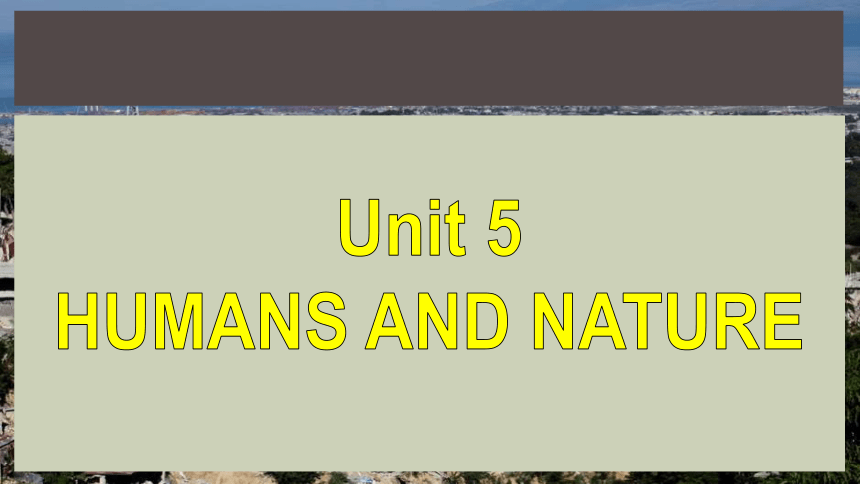 | |
| 格式 | pptx | ||
| 文件大小 | 7.4MB | ||
| 资源类型 | 教案 | ||
| 版本资源 | 北师大版(2019) | ||
| 科目 | 英语 | ||
| 更新时间 | 2024-02-23 12:07:50 | ||
图片预览



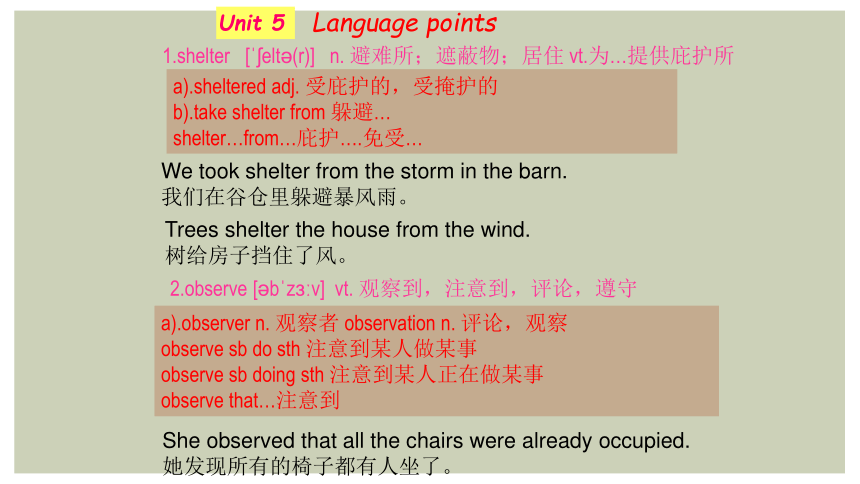
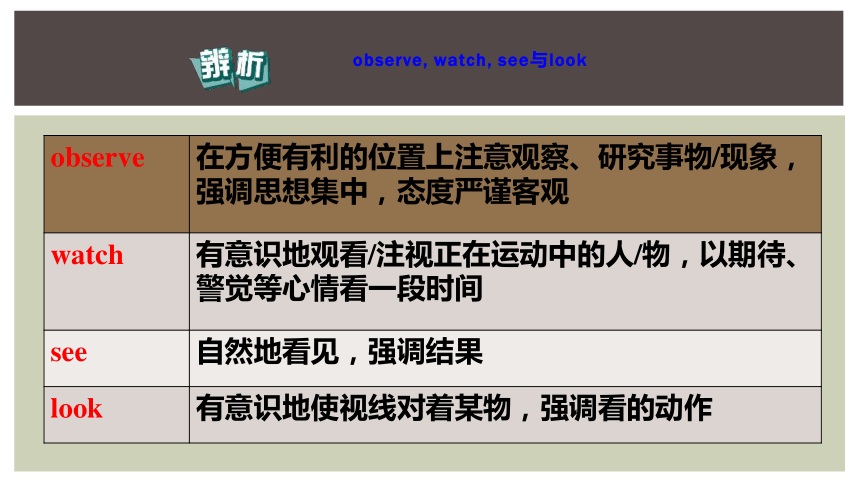
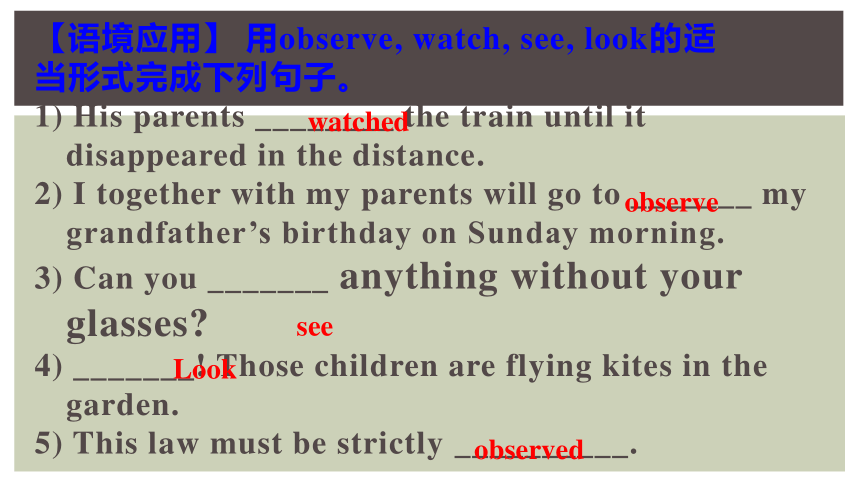
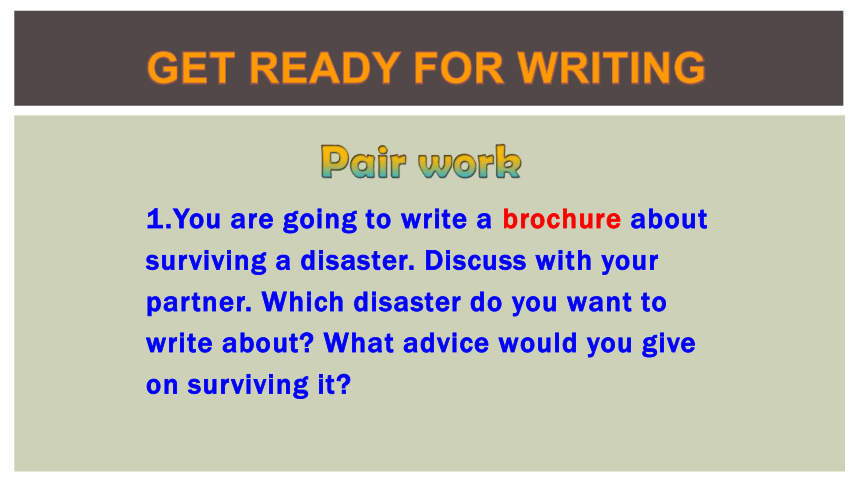
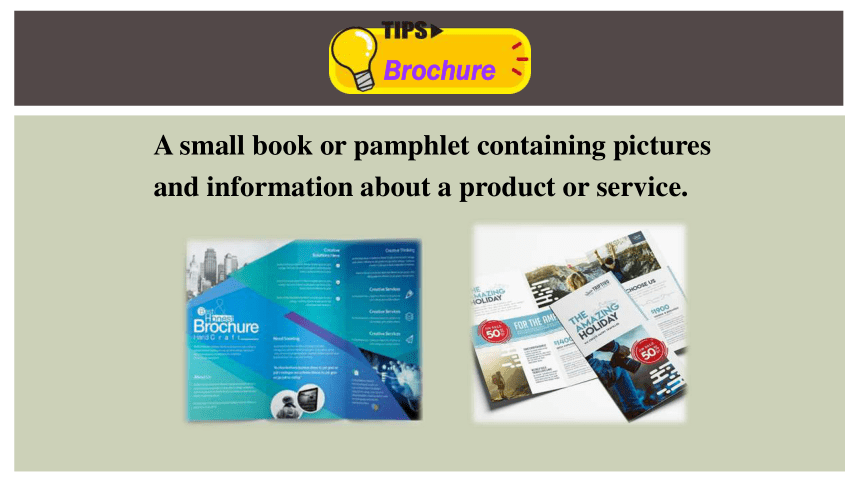
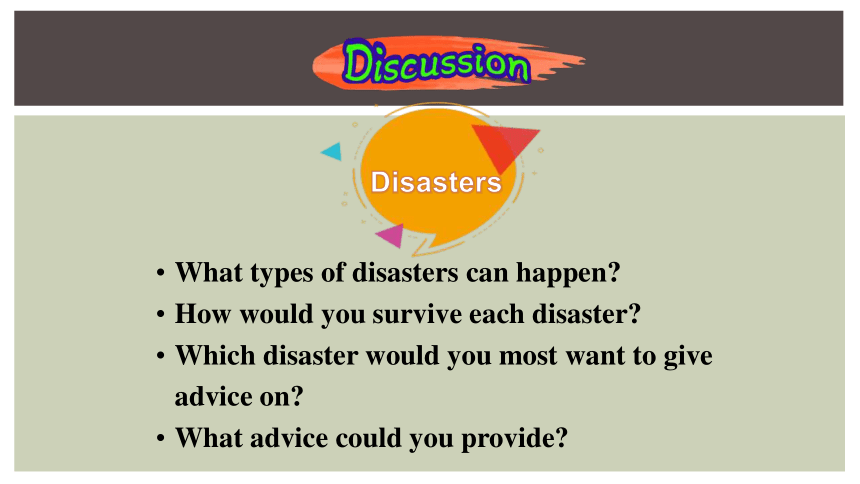
文档简介
(共24张PPT)
Unit 5
HUMANS AND NATURE
A BROCHURE
To read and talk about writing a brochure about surviving a disaster.
To read for writing.
To summarize information.
To write a brochure about surviving a disaster.
Language points
1.shelter [ elt (r)] n. 避难所;遮蔽物;居住 vt.为…提供庇护所
a).sheltered adj. 受庇护的,受掩护的
b).take shelter from 躲避…
shelter…from…庇护….免受…
Unit 5
2.observe [ b z v] vt. 观察到,注意到,评论,遵守
a).observer n. 观察者 observation n. 评论,观察
observe sb do sth 注意到某人做某事
observe sb doing sth 注意到某人正在做某事
observe that…注意到
She observed that all the chairs were already occupied.
她发现所有的椅子都有人坐了。
Trees shelter the house from the wind.
树给房子挡住了风。
We took shelter from the storm in the barn.
我们在谷仓里躲避暴风雨。
observe, watch, see与look
observe 在方便有利的位置上注意观察、研究事物/现象,强调思想集中,态度严谨客观
watch 有意识地观看/注视正在运动中的人/物,以期待、警觉等心情看一段时间
see 自然地看见,强调结果
look 有意识地使视线对着某物,强调看的动作
【语境应用】 用observe, watch, see, look的适
当形式完成下列句子。
1) His parents ________ the train until it disappeared in the distance.
2) I together with my parents will go to _______ my grandfather’s birthday on Sunday morning.
3) Can you _______ anything without your glasses
4) _______! Those children are flying kites in the garden.
5) This law must be strictly __________.
watched
observe
see
Look
observed
1.You are going to write a brochure about surviving a disaster. Discuss with your partner. Which disaster do you want to write about What advice would you give on surviving it
GET READY FOR WRITING
A small book or pamphlet containing pictures and information about a product or service.
Brochure
What types of disasters can happen
How would you survive each disaster
Which disaster would you most want to give advice on
What advice could you provide
Disasters
2.Read the brochure about surviving an earthquake on page 41. Underline what you should do when you’re indoors, outdoors and in a car.
What’s the main idea
The brochure has provided advice for three situations that a person could be during an earthquake.
READ FOR WRITING
Match the words to the correct meanings.
a type of small book/magazine that contains
pictures and information on a product or a company
(a building designed to give) protection from bad weather, danger, or attack
a sudden movement of the earth's surface that follows an earthquake and is less violent
to watch carefully the way something happens or the way someone does something, especially in order to learn more about it
a chemical element, such as iron or gold, or a
mixture of such elements, that is hard and strong
aftershock, shelter, brochure, metal, observe
brochure
shelter
aftershock
observe
metal
3.Read the brochure again. Complete the table.
How to Survive an Earthquake
Situation 1: __________
Situation 2: __________
Situation 3: __________
FOCUS ON STRUCTURE AND LANGUAGE
How to Survive an Earthquake
S 1: _________________
S 2: __________________
S 3: _________________
If you’re indoors:
If you’re outdoors:
If you’re in a car:
Don’t run, but protect yourself.
Drop, cover and hold on.
Move away from anything that can fall.
Find a shelter where you can stay.
Wait before moving to another place.
Stop.
Stay seated.
Drive carefully when the quake stops.
4.Look at the Sentence Builder below. Write a few sentences that you may want to include in your brochure about Dos and Don’ts for surviving a particular disaster.
Imperatives for dos and Don’ts
Dos
Drop down onto your hands and knees.
Cover your head and neck with your hands, arms or hard objects.
Don’ts
Don’t try to run out of the building during an earthquake.
Discuss Dos and don’ts using the brochure on page 41.
Pair work. Write a few dos and don’ts for surviving the disaster that you chose before.
Write your sentences, then check with your partner.
5.Use the structure in Activity 3 to prepare an outline for your brochure.
COMPOSE YOUR WRITING
Think about the elements of your brochure.
Compose your own brochure according to the disaster that you chose before.
Think about these questions:
different situations;
dos and don’ts;
dangers and protection
…
6.Use your outline and the Writing Help to write your first draft.
A draft is the first version of a piece of writing.
Use your outline to write complete sentences.
Pay attention to the Sentence Builder.
Read the Writing Help below.
Writing a Brochure
It’s important to:
be clear and direct;
use simple and clear language. Make the information easy to remember;
give advice with reasons for actions in different situations;
use the present tense and imperatives;
include pictures and key words to show the important actions.
Writing Help
7.Edit your brochure in pairs. Then share
what you have written in class.
Editing is the final stage of writing, before publishing.
When you edit, check your ideas are clear and your sentences are complete.
Exchange your writing with your partner and offer suggestions. Make changes to your drafts.
A Brochure
Does the writer focus on a clear topic
Does the writer make clear and direct points
Does the writer use simple and clear language
Does the writer give advice with reasons for different situations
Does the writer use the present tense and imperatives
Choose one of the following activities.
1. Watch the video and write a brochure of How to Survive a Flood.
2. Choose a disaster and write a brochure.
typhoon tsunami
Unit 5
HUMANS AND NATURE
A BROCHURE
To read and talk about writing a brochure about surviving a disaster.
To read for writing.
To summarize information.
To write a brochure about surviving a disaster.
Language points
1.shelter [ elt (r)] n. 避难所;遮蔽物;居住 vt.为…提供庇护所
a).sheltered adj. 受庇护的,受掩护的
b).take shelter from 躲避…
shelter…from…庇护….免受…
Unit 5
2.observe [ b z v] vt. 观察到,注意到,评论,遵守
a).observer n. 观察者 observation n. 评论,观察
observe sb do sth 注意到某人做某事
observe sb doing sth 注意到某人正在做某事
observe that…注意到
She observed that all the chairs were already occupied.
她发现所有的椅子都有人坐了。
Trees shelter the house from the wind.
树给房子挡住了风。
We took shelter from the storm in the barn.
我们在谷仓里躲避暴风雨。
observe, watch, see与look
observe 在方便有利的位置上注意观察、研究事物/现象,强调思想集中,态度严谨客观
watch 有意识地观看/注视正在运动中的人/物,以期待、警觉等心情看一段时间
see 自然地看见,强调结果
look 有意识地使视线对着某物,强调看的动作
【语境应用】 用observe, watch, see, look的适
当形式完成下列句子。
1) His parents ________ the train until it disappeared in the distance.
2) I together with my parents will go to _______ my grandfather’s birthday on Sunday morning.
3) Can you _______ anything without your glasses
4) _______! Those children are flying kites in the garden.
5) This law must be strictly __________.
watched
observe
see
Look
observed
1.You are going to write a brochure about surviving a disaster. Discuss with your partner. Which disaster do you want to write about What advice would you give on surviving it
GET READY FOR WRITING
A small book or pamphlet containing pictures and information about a product or service.
Brochure
What types of disasters can happen
How would you survive each disaster
Which disaster would you most want to give advice on
What advice could you provide
Disasters
2.Read the brochure about surviving an earthquake on page 41. Underline what you should do when you’re indoors, outdoors and in a car.
What’s the main idea
The brochure has provided advice for three situations that a person could be during an earthquake.
READ FOR WRITING
Match the words to the correct meanings.
a type of small book/magazine that contains
pictures and information on a product or a company
(a building designed to give) protection from bad weather, danger, or attack
a sudden movement of the earth's surface that follows an earthquake and is less violent
to watch carefully the way something happens or the way someone does something, especially in order to learn more about it
a chemical element, such as iron or gold, or a
mixture of such elements, that is hard and strong
aftershock, shelter, brochure, metal, observe
brochure
shelter
aftershock
observe
metal
3.Read the brochure again. Complete the table.
How to Survive an Earthquake
Situation 1: __________
Situation 2: __________
Situation 3: __________
FOCUS ON STRUCTURE AND LANGUAGE
How to Survive an Earthquake
S 1: _________________
S 2: __________________
S 3: _________________
If you’re indoors:
If you’re outdoors:
If you’re in a car:
Don’t run, but protect yourself.
Drop, cover and hold on.
Move away from anything that can fall.
Find a shelter where you can stay.
Wait before moving to another place.
Stop.
Stay seated.
Drive carefully when the quake stops.
4.Look at the Sentence Builder below. Write a few sentences that you may want to include in your brochure about Dos and Don’ts for surviving a particular disaster.
Imperatives for dos and Don’ts
Dos
Drop down onto your hands and knees.
Cover your head and neck with your hands, arms or hard objects.
Don’ts
Don’t try to run out of the building during an earthquake.
Discuss Dos and don’ts using the brochure on page 41.
Pair work. Write a few dos and don’ts for surviving the disaster that you chose before.
Write your sentences, then check with your partner.
5.Use the structure in Activity 3 to prepare an outline for your brochure.
COMPOSE YOUR WRITING
Think about the elements of your brochure.
Compose your own brochure according to the disaster that you chose before.
Think about these questions:
different situations;
dos and don’ts;
dangers and protection
…
6.Use your outline and the Writing Help to write your first draft.
A draft is the first version of a piece of writing.
Use your outline to write complete sentences.
Pay attention to the Sentence Builder.
Read the Writing Help below.
Writing a Brochure
It’s important to:
be clear and direct;
use simple and clear language. Make the information easy to remember;
give advice with reasons for actions in different situations;
use the present tense and imperatives;
include pictures and key words to show the important actions.
Writing Help
7.Edit your brochure in pairs. Then share
what you have written in class.
Editing is the final stage of writing, before publishing.
When you edit, check your ideas are clear and your sentences are complete.
Exchange your writing with your partner and offer suggestions. Make changes to your drafts.
A Brochure
Does the writer focus on a clear topic
Does the writer make clear and direct points
Does the writer use simple and clear language
Does the writer give advice with reasons for different situations
Does the writer use the present tense and imperatives
Choose one of the following activities.
1. Watch the video and write a brochure of How to Survive a Flood.
2. Choose a disaster and write a brochure.
typhoon tsunami
同课章节目录
- Unit 4 Information technology
- Lesson 1 Avatars
- Lesson 2 Apps
- Lesson 3 Internet and Friendships
- Unit 5 Humans and nature
- Lesson 1 A Sea Story
- Lesson 2 Professional Rescue Team
- Lesson 3 Race to the Pole
- Unit 6 The admirable
- Lesson 1 A Medical Pioneer
- Lesson 2 History Makers
- Lesson 3 The Superhero Behind Superman
